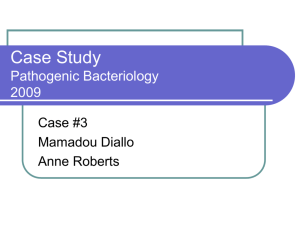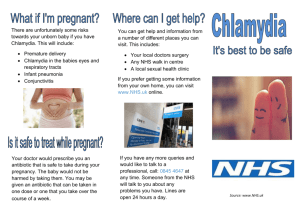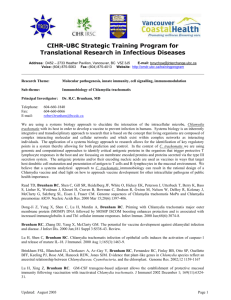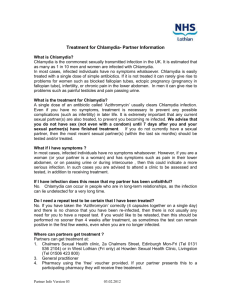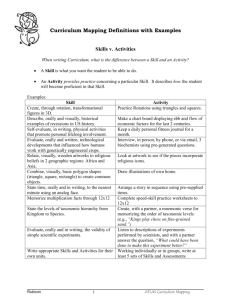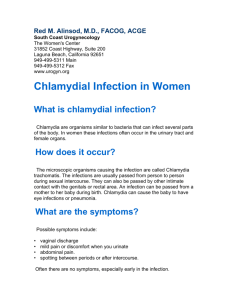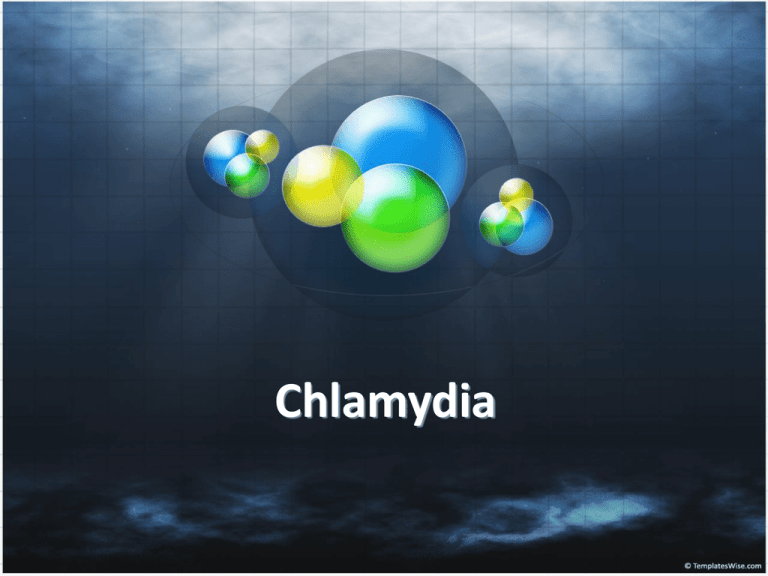
Chlamydia
Lessons
I.
Epidemiology: Disease in the U.S.
II.
Pathogenesis
III.
Clinical manifestations
IV.
Diagnosis
V.
Patient management
VI.
Prevention
Lesson I: Epidemiology:
Disease in the U.S.
Incidence
Estimated 3 million cases in U.S. annually
Most frequently reported STD in U.S.
Reported rates 3 times higher in females than in
males
Incidence and Cost
Most frequently reported STI in the U.S.
Estimated 2.9 million new infections in U.S. annually
Reported rates 3 times higher in females than in males
Estimated annual incidence of selected STIs:
Human Papillomavirus (HPV) — 14.1 million
Trichomoniasis — 1.1 million
Gonorrhea — 820,000
Herpes Simplex Virus (HSV) —776,000
Syphilis — 55,4000
Direct and indirect annual costs total approximately $2.4 billion
Chlamydia—Rates of Reported Cases by State,
United States and Outlying Areas, 2013
NOTE: The total rate of reported cases of chlamydia for the United States and outlying areas
(Guam, Puerto Rico, and Virgin Islands) was 443.5 per 100,000 population.
6
Chlamydia—Rates of Reported Cases by Sex,
United States, 1993–2013
NOTE: As of January 2000, all 50 states and the District of Columbia have regulations that
require the reporting of chlamydia cases.
7
Chlamydia—Rates of Reported Cases by Age and
Sex, United States, 2013
Chlamydia—Rates of Reported Cases by Race/Ethnicity
and Sex, United States, 2013
*AI/AN = American Indians/Alaska Natives; NHOPI = Native Hawaiian and Other Pacific Islanders.
NOTE: Includes 47 states and the District of Columbia9 reporting race/ethnicity data in Office of Management
and Budget compliant formats in 2013.
Chlamydia—Prevalence Among Persons Aged 14–39 Years by Sex,
Race/Ethnicity, or Age Group, National Health and Nutrition
Examination Survey, 2005–2008
NOTE: Error bars indicate 95% confidence intervals.
Risk Factors
Adolescence
New or multiple sex partners
History of STI
Presence of another STI
Oral contraceptive user
Lack of barrier contraception
Transmission
Transmission is sexual or vertical
Highly transmissible
> 50% of sexual partners acquire infection
60%–70% of infants exposed during passage through
birth canal acquire infection
Incubation period 7–21 days
Significant asymptomatic reservoir
Reinfection is common
Lesson II: Pathogenesis
Microbiology
Obligatory intracellular bacteria
Infect columnar epithelial cells
Survive by replication that results in the death of the
cell
Takes on two forms in its life cycle
Elementary body (EB)
Reticulate body (RB)
Source: California STD/HIV Prevention Training Center
Chlamydiaceae Family
(species that cause disease in humans)
Species
Disease
C. trachomatis
2 biovars, non-LGV
LGV
Trachoma, NGU,
MPC, PID,
conjunctivitis,
Infant pneumonia,
LGV
C. pneumoniae
Pharyngitis,
bronchitis,
pneumonia
C. psittaci
Psittacosis
Lesson III: Clinical
Manifestations
Clinical Syndromes Caused by C. trachomatis
Local Infection
Men
Urethritis
Proctitis
Conjunctivitis
Women
Cervicitis
Urethritis
Proctitis
Conjunctivitis
Infants
Conjunctivitis
Pneumonitis
Pharyngitis
Rhinitis
Complication
Sequelae
Epididymitis
Reactive arthritis
(rare)
Infertility (rare)
Chronic arthritis
(rare)
Endometritis
Salpingitis
Perihepatitis
Reactive arthritis
(rare)
Infertility
Ectopic pregnancy
Chronic pelvic pain
Chronic arthritis
(rare)
Chronic lung
disease?
Rare, if any
C. trachomatis Infection in
Men
Urethritis–One cause of nongonococcal urethritis (NGU)
Majority (>50%) asymptomatic
Symptoms/signs if present: mucopurulent, mucoid or clear
urethral discharge, dysuria
Incubation period unknown (probably 7–21 days in
symptomatic infection)
Nongonococcal Urethritis:
Mucoid Discharge
Source: Seattle STD/HIV Prevention Training Center at the University of
Washington/UW HSCER Slide Bank
C. trachomatis
Complications in Men
Epididymitis
Reactive Arthritis
Swollen or Tender
Testicles (epididymitis)
C. trachomatis
Infections in Women
Cervicitis
Majority are asymptomatic
Local signs of infection, when present, include
Mucopurulent endocervical discharge
Edematous cervix with erythema and friability
Urethritis
Usually asymptomatic
Signs/symptoms, when present, include dysuria,
frequency, “sterile” pyuria
Normal Cervix
Chlamydial Cervicitis
Source: STD/HIV Prevention Training Center at the University of
25
Washington/Connie Celum and Walter Stamm
Cervicitis
26
Source: St. Louis STD/HIV Prevention Training
Center
C. trachomatis Complications in
Women
Pelvic Inflammatory Disease (PID)
Endometritis
Salpingitis
Tubo-ovarian abcess
Peritonitis
Perihepatitis (Fitz-Hugh-Curtis Syndrome)
Reactive arthritis
Normal Human Fallopian Tube Tissue
28
Source: Patton, D.L. University of Washington,
Seattle, Washington
C. trachomatis Infection (PID)
29
Source: Patton, D.L. University of Washington,
Seattle, Washington
Acute Salpingitis
Source: Cincinnati STD/HIV Prevention Training
Center
30
Other Less Common C. trachomatis
Syndromes Seen in Men or Women
Non-LGV serovars
Conjunctivitis
Proctitis
Reactive arthritis
LGV serovars
Lymphogranuloma venereum
LGV Lymphadenopathy
32 Clinical Slides
Source: CDC Division of STD Prevention
C. trachomatis Infections
in Infants
Perinatal clinical manifestations:
Inclusion conjunctivitis
Pneumonia
C. trachomatis Infections
in Children
Preadolescent males and females
Urogenital infections
Usually asymptomatic
Vertical transmission
Sexual abuse
Lesson IV: Diagnosis
35
Chlamydia Diagnostics
• Preferred
o Nucleic acid amplification tests (NAATs)
Acceptable in limited circumstances
o Culture
• Not recommended
o Non-amplification tests
o Serology
NAATs
NAATs amplify and detect organism-specific
genomic or plasmid DNA or rRNA
A number of NAATs are commercially available.
They include
Abbott LCx
Artus/Qiagen RealArt PCR
Becton Dickinson BDProbe Tec®
Gen-Probe AmpCT, Aptima®
Roche Amplicor®
Some can detect C. trachomatis and
gonorrhoeae in the same specimen.
N.
Significantly more sensitive than other tests.
NAATs (continued)
FDA cleared
- All NAATs
o urethral swabs from men
o cervical swabs for women
o urine from men and women
- Certain NAATs
o vaginal swabs
Not FDA cleared
Rectal
Pharyngeal
Some laboratories have met regulatory requirements
Culture
Historically the “gold standard”
Variable sensitivity (50% – 80%)
High specificity
Use in legal investigations
Approved for use in all anatomical sites
Not suitable for widespread screening
Non-Amplification Tests:
Not Recommended
Less expensive than culture or NAATs, but sensitivity
only 50 – 75%
Direct fluorescent antibody (DFA)
Detects intact bacteria with a fluorescent antibody
Variety of specimen sites
Enzyme immunoassay (EIA)
Detects bacterial antigens with an enzyme-labeled antibody
Nucleic acid hybridization (NA probe)
Detects specific DNA or RNA sequences of C. trachomatis
and N. gonorrhoeae
Serology
Rarely used for uncomplicated infections
Comparative data between types of serologic
test are lacking
Criteria used in LGV diagnosis
Complement fixation titers >1:64 can support
diagnosis of LGV in the appropriate clinical
context.
Serologic test interpretation for LGV is not
standardized.
Lesson V: Patient
Management
42
Treatment of Uncomplicated
Genital Chlamydial Infections
CDC-recommended regimens
Azithromycin 1 g orally in a single dose, or
Doxycycline 100 mg orally twice daily for 7 days
Alternative regimens
Erythromycin base 500 mg orally 4 times a day for 7 days, or
Erythromycin ethylsuccinate 800 mg orally 4 times a day for 7 days, or
Ofloxacin 300 mg orally twice a day for 7 days, or
Levofloxacin 500 mg orally once a day for 7 days
Treatment of Chlamydial
Infection in Pregnant Women
CDC-recommended regimens
Azithromycin 1 g orally in a single dose, or
Amoxicillin 500 mg orally 3 times a day for 7 days
Alternative regimens
Erythromycin base 500 mg orally 4 times a day for 7 days, or
Erythromycin base 250 mg orally 4 times a day for 14 days, or
Erythromycin ethylsuccinate 800 mg orally 4 times a day for 7 days, or
Erythromycin ethylsuccinate 400 mg orally 4 times a day for 14 days
Treatment of Neonatal Conjunctivitis
and/or Pneumonia
CDC-recommended regimen
Erythromycin base or ethylsuccinate 50 mg/kg/day
orally divided into 4 doses daily for 14 days
Treatment of Chlamydial Infection
in Children
Children who weigh <45 kg
Erythromycin base or ethylsuccinate 50 mg/kg/day orally divided into 4
doses daily for 14 days
Children who weigh ≥45 kg, but are <8 years of age
Azithromycin 1 g orally in a single dose
Children ≥8 years of age:
Azithromycin 1 g orally in a single dose, or
Doxycycline 100 mg orally twice a day for 7 days
Treatment of Lymphogranuloma
Venereum (LGV)
CDC-recommended regimen
Doxycycline 100 mg orally twice a day for 21 days
Alternative regimen
Erythromycin base 500 mg orally 4 times a day for 21
days
Repeat Testing after Treatment
Pregnant women
Test of cure, by NAAT, 3 weeks after completion of therapy
Repeat testing for reinfection 3 months after completion of therapy
Nonpregnant women and men
Repeat testing 3 months after treatment is recommended to detect reinfection with C. trachomatis
If not possible, then repeat testing should be performed at next
presentation for care within 12 months
Test of cure (3 weeks after therapy) is not recommended, but can be
considered when
compliance is in question,
symptoms persist,
re-infection is suspected, or
erythromycin is used.
Lesson VI: Prevention
Why Screen for
Chlamydia?
Most infections are asymptomatic
Screening may reduce the incidence of PID by more
than 50% and may decrease the prevalence of infection
in the population
Screening Recommendations:
Nonpregnant Women
Sexually-active women < age 25 years should be
screened annually
Women ≥25 years old should be screened if risk
factors are present.
Repeat testing of all women 3 months after
treatment for C. trachomatis infection.
If not possible, then repeat testing should be
performed at next presentation for care within 12
months.
Screening Recommendations:
Pregnant Women
Screen all pregnant women at the first prenatal visit.
Pregnant women aged <25 years and those at
increased risk for chlamydia should be screened
again in the third trimester.
Screening Recommendations:
Men
Screening of sexually-active young men should be
considered in clinical settings with a high prevalence of
chlamydia and when resources permit.
Repeat testing is recommended for all men 3
months after treatment for C. trachomatis infection
If not possible, then repeat testing should be performed
at next presentation for care within 12 months.
Partner Management
Sex partners should be evaluated, tested, and treated if they
had sexual contact with the patient during the 60 days
preceding the onset of symptoms or diagnosis of chlamydia.
Most recent sex partner should be evaluated and treated, even
if the time of the last sexual contact was >60 days before
symptom onset or diagnosis.
Expedited partner therapy (EPT) - Delivery of therapy to sex
partners by heterosexual male or female patients (“patientdelivered partner therapy”) is an option in some jurisdictions
Reporting
Chlamydia is a reportable STD in all states.
All clinicians and laboratories must report cases to
the local or state STD program.
Prevention Counseling
Nature of the infection
Chlamydia is commonly asymptomatic in men and
women
In women, there is an increased risk of upper
reproductive tract damage with reinfection.
Transmission issues
Effective treatment of chlamydia may reduce HIV
transmission and acquisition.
Abstain from sexual intercourse until partners are
treated and for 7 days after a single dose of
azithromycin or until completion of a 7-day doxycycline
or alternative regimen.
Prevention Counseling
(continued)
Risk reduction
The clinician should
Assess the patient’s behavior-change potential.
Discuss prevention strategies (abstinence,
monogamy, condoms, limit number of sex
partners, etc.). Latex condoms, when used
consistently and correctly, can reduce the risk of
transmission of chlamydia.
Develop individualized risk-reduction plans.
Case Study
History
Suzy Jones: 17-year-old college student who presents to the
Student Health Center seeking advice about contraception
Shy talking about her sexual practices
Has never had a pelvic exam
Has had 2 sex partners in past 6 months
Does not use condoms or any other contraceptives
Her periods have been regular, but she has recently noted
some spotting between periods. Last menstrual period was 4
weeks ago.
Denies vaginal discharge, dyspareunia, genital lesions, or
sores
Physical Exam
Vital signs: blood pressure 118/68, pulse 74,
respiration 18, temperature 37.1° C
Breast, thyroid, and abdominal exam within normal
limits
Genital exam reveals normal vulva and vagina
The cervix appears inflamed, bleeds easily, with a
purulent discharge coming from the cervical os.
Bimanual exam is normal without cervical motion
pain, uterine or adnexal tenderness.
Questions
1.
What is the initial clinical diagnosis?
2.
What is the most likely microbiologic diagnosis?
3.
Which laboratory tests should be ordered or
performed?
4.
What is the appropriate treatment at the initial
visit?
Laboratory Results
NAAT for Chlamydia trachomatis: positive
NAAT for Neisseria gonorrhoeae: negative
Wet mount: pH 4.2, no clue cells or trichomonads
but numerous WBCs
KOH preparation: negative for “whiff test”
HIV antibody test: negative
Pregnancy test: negative
Questions
5. What is the final diagnosis?
6.
What are the appropriate prevention and
counseling messages for Suzy?
7.
Who is responsible for reporting this case to the
local health department?
Partner Management
Suzy’s sex partners from the past year:
John – Last sexual exposure 5 weeks ago
Tom – Last sexual exposure 7 months ago
Michael – Last sexual exposure 2 weeks ago
8. Which sex partners should be evaluated, tested, and
treated?
Follow-Up
Suzy returned for a follow-up visit at 3 months
‾Her repeat chlamydia test returned positive
‾Suzy stated that her partner, Michael, went to get tested,
but the test result was negative so he was not treated
9. What is the appropriate treatment at the 3month follow-up visit?

